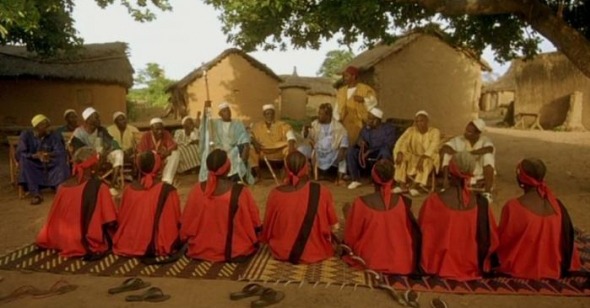Rebels with Cause
by Saul Austerlitz
Moolaadé
Dir. Ousmane Sembene, Senegal, New Yorker Films
To some, the desire to sympathize in the struggle between change and tradition, with those who seek to modernize may appear to mask a desire to bleach out the remarkable diversity of the human race into a shapeless morass of uniformity. I prefer to see it as a need to share the gifts of modernity, which include, at its best moments, an increased freedom from dread. Ousmane Sembene, the 81-year-old father of African filmmaking, tackles this thorny material in his latest film, Moolaadé, the second film of his proposed trilogy dealing with Senegalese women following 2000's Faat Kiné. Set in a prototypical Senegalese village, Moolaadé is the story of Colle, a woman who provides an order of protection (moolaadé) to a handful of young girls who refuse to undergo the painful and hideous ritual of female genital mutilation, in which the clitori of 10 and 11-year-old girls are cut off. It is also the story of a village, and a society, in turmoil, torn between the call of tradition and the pull of modernity.
Sembene's film is a feminist parable painted in a riot of bold colors and told with a jauntiness that belies the soberness of his themes about women coming together to make a change in their own homes and communities. The struggle, in Sembene's telling, is a battle of the sexes, in which men are the enforcers of authority, demanding obedience from the women, who crave change, in the form of equal freedom and knowledge. However, Sembene's analysis is more complex, for it is the women, or some subset thereof, who are the staunchest upholders of tradition as well. The older women of the village serve as deans of the purification rite, and may represent those most horrified at the rejection of longstanding communal standards. Sembene plays a wicked trick by introducing a character early on, the son of the local leader (the Digoutigi) who has just returned from Paris and is planning on marrying Amsatou, Colle's daughter. Young, male, educated, and newly Europeanized (one young boy practically slobbers all over his gleaming shoes), he seems a perfect leader for the modernizing rebellion to come. But then, the much-anticipated conflict comes, and the women (uneducated, backward, distinctly un-European) are left to fight the battle for modernity themselves. No man, and no European, is required to lead the charge. Sembene generously gives the Digoutigi's son the final word anyway, and after vanishing for so much of the difficulty and anguish of the village's struggles, he redeems himself by standing up to his father and proclaiming a new era in the life of their town. After his father has smacked him for his disobedience, he takes a moment to gather his dignity, and responds, “Father, it is easy to hit a son, but the era of little tyrants is over.”
The film, though, belongs to Colle, rebellious second wife of a placid and kind older man. Having chosen not to subject her daughter, Amsatou, to the ritual some years prior, she sees no choice but to extend similar protection to a few girls wishing to avoid a similar fate. They may have escaped, but two of their friends were less fortunate, choosing instead to jump into a well. Without rancor, Sembene documents a society from which the lives of women, let alone their beliefs and interests, are barely valued. The village's leaders are less concerned with the ritual of genital mutilation itself, which they view as women's matters, than with the continued smooth functioning of their society's hierarchy, which places women in a distinctly inferior role. The cutting ritual, an animist leftover in an Islamic society, is pronounced Muslim doctrine by the village leaders. It is only by listening to their contraband radios that the women hear an imam pronounce genital mutilation distinctly un-Muslim. When threatened with this knowledge, they pull out their trump card: bilakoro (unpurified) women are ineligible for marriage.
Colle's husband returns from a business trip, and is immediately confronted by his elder brother, his superior in the village's pecking order. His brother orders him to confront and restrain Colle, by force if necessary. Sembene cuts between a young girl's hideous, blood-curdling screams as she is forcibly mutilated, and Colle's engaging in rough sex with her husband. During intercourse, her pinky finger is cut, and the next morning, taking a bath, she gazes at her wound, a visible reminder of the trauma of mutilation facing the girls under her protection. According to the elder brother, though, the purification rite is demanded by Islam, and who is, Colle, to make changes to the natural order of things? Her husband beats her mercilessly, but Colle does not break, and refrains from uttering the words that would end the moolaade and restore the girls to their families, and to the desecration of their genitals.
Fists and sticks and worse may be the tools of intimidation and violence used here (Mercenaire, the cheerfully amoral itinerant salesman who prevents Colle's husband from beating her further, is murdered by the village leaders for his courageous intervention), but ultimately, it is the power of an idea that reigns triumphant. That idea is of equality, and of increased engagement with the modern world. Moolaadé repeatedly offers a shot of the village's central square, where two buildings stand: a mosque and an animist place of worship. When threatened by change, the village's authoritarians collapse their long tradition of compromise and eclecticism into a suffocating veil of tradition, but the very architecture of their village speaks of a different history. Following the upheaval, order is restored through another symbolic balancing of conflicting traditions: Sembene ends the film with a shot of the traditional ostrich's egg, placed at the top of the mosque, now joined by that familiar rooftop accoutrement, the television antenna.
